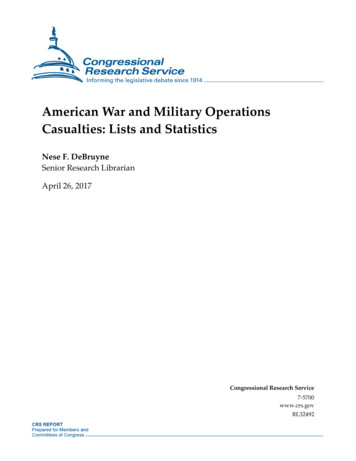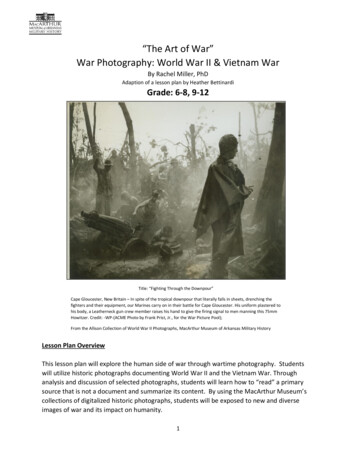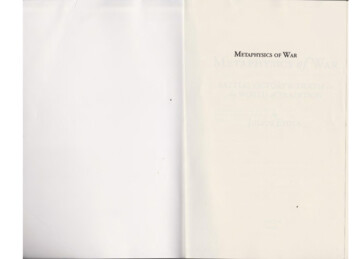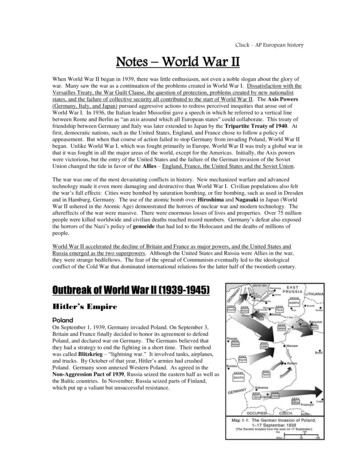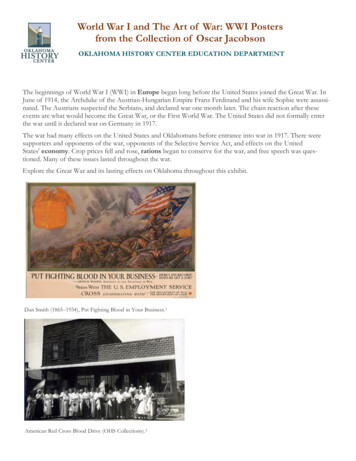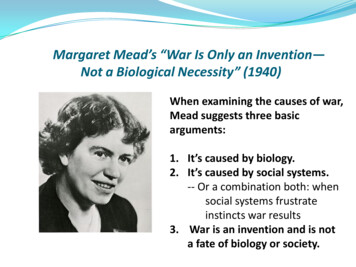
Transcription
Studies in Intelligence Vol. 50 No. 2 (2006)Intelligence in War: It CanBe DecisiveWinning with IntelligenceGregory ElderNow the reason the enlightened prince and the wise general conquer the enemywhenever they move and their achievements surpass those of ordinary men isforeknowledge. —Sun Tzu, The Art of War[1]Ever present in militarydiscussions are questions ofHistory repeatedly hasforce composition and forcedemonstrated that inferior forcesemployment in winningcan win when leaders are armedbattles. Several notable works,with accurate intelligence.such as Stephen Biddle’sMilitary Power: Explaining Victoryand Defeat in Modern Battle,have addressed such controversial force employment questions as: Whatweight should be given to employment vice that of technology or mass?Can mass win in technology-heavy environments? How effective candoctrine and tactics be in preparing forces to be used?[2] Other works,such as John Keegan’s Intelligence in War, argue that blunt force is theprimary variable in achieving victory: “Willpower always counts for morethan foreknowledge.”[3]
Force and its employment are significant in driving outcomes in combat.However, it is operational and tactical intelligence, not necessarilynumbers, technology, or tactics, that can have the most decisive impacton how forces are employed and how success is achieved in wartimeoperations. History repeatedly has demonstrated that numerically inferiorforces, armed with less capable technologies, can win when leaders arearmed with accurate intelligence they believe they can act upon. Suchintelligence can be a force multiplier. Therefore, considering the value offorce employment, technology, and mass without placing a correspondingvalue on intelligence is a mistake.In this article I explore the role of tactical and operational intelligence indictating force employment schemes and as a decisive element in fivestrategically significant battles— the First Battle of Bull Run (1861),Tannenberg (1914), Midway (1942), Inchon (1950), and the Israeli air strikeinitiating the Six-Day War in 1967—and I will demonstrate that it wasneither technology nor material superiority that won the day, but accurate,timely, actionable intelligence, combined with leaders willing to treatintelligence as a primary factor in deciding outcomes. In each case,intelligence gave commanders the knowledge of the battlefield(battlespace awareness) and the understanding of their foe to focus theirforces at the right place and time to win when, in all probability, theyshould have been defeated. Certainly ADM Chester Nimitz, faced with thejob of reversing the losses at Pearl Harbor, would have disputed RADMThomas A. Brooks’ assertion that intelligence is a secondary factor in war,as would General P. T. Beauregard, who, in 1861, faced the grim possibilityof losing the first major battle of the Civil War.[4]Te Batle of Bull Run: 21 July 1861The battle may be most renowned for the last minute heroics of General“Stonewall” Jackson on Henry House Hill, which led to the rout of theUnion army, but the Confederates were able to employ the forces neededto win at Bull Run because they had created, months earlier, an intricatespy network in Washington, DC. By the time the fledgling Union Army hadorganized itself for its first major campaign into Virginia, its troopstrengths, dispositions, and plans had long been compromised. SaidBeauregard, commanding Confederate forces in northern Virginia, “I wasalmost as well advised of the strength of the hostile army in my front as itscommander.”[5]
In May 1861, just weeks after the announcement of the fall of Fort Sumter,a spy in the quartermaster office of the US War Department had begunrecruiting a ring of Confederate sympathizers in the nation’s capital.Among these were bankers, clerks, couriers, housewives, and RoseGreenhow, proprietor of a respectable salon frequented by seniorgovernment and military officials. While the network mobilized, a Unionforce of nearly 36,000 was organizing and training just across the PotomacRiver. Its commander, General Irvin McDowell, was under pressure fromLincoln to strike the Confederates at the earliest possible date.While the Union Army was concentrated, Confederate forces were split,with 21,000 stationed at Manassas Junction under Beauregard, and 12,800under General Joseph E. Johnston near Harper’s Ferry. Combined, theConfederate troops still numbered fewer than the Federals, and divided,they stood little chance against a concerted Union offensive. Yet,authorities in Richmond, worried about a Federal incursion down theShenandoah Valley by a force of 18,000 at Harpers Ferry, had toldBeauregard he could unite the two armies only if an attack was imminent.Thus, a McDowell move toward Manassas would spark a race in whichJohnston would have to rush to Beauregrad’s aid across piedmont terrainand with limited railroad access. His ability to win this race was possibleonly if he received timely, detailed, and believable intelligence indicatingwhen, where, and with what forces McDowell would strike. Beauregard’sfate rested in the hands of a few neophyte clandestine agents.On 10 July the network demonstrated its worth, as Rose Greenhow sentword that “McDowell has certainly been ordered to advance on thesixteenth.”[6] This intelligence, however, proved insufficient to start therace. President Davis denied requests to authorize relocation of Johnston’sarmy. Beauregard, fearing the worst, sent a plea to Greenhow forintelligence reconfirming the date and planned movement of Union forces.On 16 July, she sent word that the Federal forces would move out that veryday, marching from Arlington to Manassas, via Centreville, a distance ofonly 20 miles. This information immediately made its way to Richmond.Consequently, orders were dispatched that night directing Johnston tomove south in haste and unite with Beauregard’s forces on the Bull Run.
McDowell began his march on the 16th, as Greenhow had reported,crossed the Bull Run at Sudley Ford on the 21st, and attacked theConfederate left flank on Matthews Hill. Fighting raged throughout theday, and Beauregard’s forces were driven back to Henry Hill. Defeatseemed imminent. Late in the afternoon, however, Johnston’sreinforcements, having arrived via rail at Manassas Junction the nightbefore, made their way to the battle and broke the Union right flank. What
seemed a victory for the Federals rapidly deteriorated into a disorganizedretreat. And while it was Jackson’s brigade under Johnston’s commandthat turned the tide of a hard fought battle, it was espionage thatprovided alternatives to Confederate political and military decisionmakers,allowing them to concentrate their forces and demonstrate that theycould defeat the Union in a major engagement. Victory was not certain—defeat was avoided only as a result of the decision to reinforceBeauregard. In What If? , Stephen Sears sugests that without a geographicpoint at which to regroup, the Confederate Army might have dissolved andthe rebellion ended in its first year if the Union had won that day.[7]Intelligence in this case gave the Confederates several advantages. First,with reliable information on the Union order of battle and strategy, theywere able to split their smaller forces to defend the Shenandoah Valleyand to maintain a check on McDowell’s army. Second, because of theexistence of timely indicators and warning, it was inconceivable that theFederals could execute a surprise attack against the Confederates; agentswere able to provide fresh, corroborated information on everything theFederals did. Finally, Beauregard knew the strength of his opponent andthe route of attack and, therefore, had the ability to consolidate andposition his forces on the most advantageous ground. This was all themore important as McDowell had a well-developed concept of operationsand superior numbers. Yet force alone cannot win the day.Batle of Tannenberg: 23–30 August 1914The Battle of Tannenberg was one of the largest, yet least known,strategically decisive victories in modern warfare. Its outcome allowed theGermans to recover momentum after their loss at the Battle of the Marneon the Western Front, to save Prussia from the Russians, to defeat threesuccessive Russian armies, and to deal the first of several blows leading tothe Treaty of Brest Litovsk and the Russian Revolution in 1917. Of theroughly 150,000 Russian soldiers who fought in the battle of Tannenberg,some 30,000 were killed or wounded and another 95,000 captured. TheGermans suffered fewer than 20,000 casualties, captured more than 500guns, and filled dozens of trains with captured equipment for transport toGermany.After losing at Tannenberg, the Russian army could not muster enoughoffensive strength to re-enter Germany again until World War II. It was
nothing short of a complete victory for Germany, and it came in large partbecause of the German Army’s successful use of intelligence.Modifying the Schlieffen Plan at the outset of the war, Germany sent onlyone army, the Eighth, to the Eastern Front to face the presumed, slow-tomobilize Russian armies. Misperceiving how quickly the Russians couldbring their forces to bear, the Eighth quickly found itself facing twoRussian armies—the First moving west into Prussia, and the Seconddriving northwest from southern Prussia. While the German Eighth Armywas comparable in size to each of the Russian armies, it could not face acombined assault.The Russian First Army struck first and won a victory at the Battle ofGumbinnen on 20 August 1914. It did not seize the initiative, however,choosing instead to wait until the Second Army could move north to catchthe Germans in a pincer. This gave Helmuth von Moltke, the German Chief
of Staff in Berlin, time to replace the commander of the Eighth Army,General Maximilian von Prittwitz, with Generals Paul von Hindenburg andErich Ludendorff, and to regroup. Rather than concede Prussia to theRussians or potentially face another defeat at the hands of the First Army,Ludendorff looked south for an opening to attack the Russian SecondArmy. He authorized the movement of a corps from Gumbinnen south viarailroad to attack the Second Army’s left flank. He also consideredmarching the bulk of his remaining forces south to envelop the right flank—this, however, would leave northern Prussia exposed to the First Army.Shifting fronts would be risky.While both side’s staffs planned for the coming great battle, a secret warwas waged behind the scenes by cryptologists. Early in the days of radiocommunications, neither side was particularly astute in communicationssecurity, and both exposed their vulnerabilities over the airwaves. But thepoorly educated and trained Russian cryptologists were unable even tomaster their simple cipher system and, in the case of the First Army, didnot use a communications code. This led to frequent lapses in securityand resulted in operators repeatedly resending messages, often uncoded,in plain language. The result was a windfall of intelligence for the Germans.Intercepting Russian communications, German cryptologists deducedtroop strengths and movement schedules, picked up orders, and, mostimportantly, messages between the First and Second Armies that showedhow poorly the two were coordinating their efforts.[8] While the Germanstaff can be credited with developing the concept of operations thatwould lead to victory in the engagement, it was communicationsintelligence that provided a clear picture of the battlefield, or in today’sparlance, the battlespace awareness.As the single German corps under General Hermann von Francois beganits attack against the exposed left flank of the Second Army on 27 August,two particularly important unencrypted communications transmitted bythe Russian First and Second Armies were intercepted.[9] The first, sent byGeneral Paul von Rennenkampf, commander of the First Army, revealedthe distance between the two armies and that Rennenkampf needed atleast three days before his army could join the Second Army in attackingthe Germans. This sugested to Ludendorff that he need not worry aboutFirst Army assistance to the Second or exploitation of the gap created byhis own army’s movement south. The second intercept, a communiquéfrom the Second Army, provided a complete description of its dispositionsand planned route of attack to the north. As important as the first, thisgave Ludendorff the foreknowledge he needed to achieve surprise and a
gdgconcentration of force against an exposed adversary.e surprisAs the bulk of the German Eighth Army advanced on the right flank of theRussian’s Second Army and the Russians’ plight became apparent,German cryptologists began intercepting pleas for assistance, as well asorders from General Zhilinski, overall commander of Russian forces,directing the First Army to move northwest, away from Second Army—aclear sign that the Russian leaders did not have a clear understanding ofGerman dispositions or just how precarious Second Army’s situation was.This knowledge emboldened the Germans. With the two corps fromGumbinnen and Francois’ corps to the south, the German forces sweptaround the Second Army and on 29 August completed the encirclementthat would spell its demise.By destroying Second Army with relatively little loss, Hindenburg andLudendorff could turn north against the First Army and a newly formedarmy, the Tenth. These were defeated at the Battle of First and SecondMasurian Lakes and effectively destroyed Russia’s capacity for carryingout offensive operations against Germany.Intelligence at Tannenberg did not win the battle, but it did play a decisiverole in dictating the way the Germans employed their units against a forcethat was, overall, larger than theirs. German leaders had a thoroughunderstanding of their adversary’s capabilities, schedules, and concept ofoperations, and this knowledge allowed them to exploit Russianvulnerabilities and defeat them in detail. Thus, if “[O]nly numbers canannihilate,” as sugested by Lord Nelson, the successful exploitation ofintelligence in this case demonstrates that they need not be superiornumbers.[10]Te Batle of Midway: 4-7 June 1942Midway was one of the decisive battles of history. The loss of her fleet carrierforce deprived Japan of the initiative; henceforward she was on the defensive—attempting to hold the great spread of the Southern Resources Area andcontiguous regions she had so handily won. Two basic factors led to the result:first and foremost, the American knowledge of the Japanese secret codes,which presented Nimitz with an accurate picture of Japanese intentions anddispositions.
—R. Earnest and Trevor Dupuy[11]As with battles on land, intelligence can drive the employment schemesnecessary for a leader to win against superior odds at sea. Midway, abattle in which intelligence allowed the United States to spring a trapagainst what the Japanese had planned as their own ambush, resulted inan immediate shift in the balance of sea power in the Pacific. TheJapanese Navy, which had a fleet of six carriers before the battle, lost fourat Midway, and it lost the bulk of its trained pilots and hundreds ofaircraft. While the United States would lose one carrier, it was left with fivespread throughout the world. Thirteen more were under construction.Yamamoto believed that for Japan to win the war it would need to destroythe carriers early.[12] Due in large part to the foresight provided by USnaval intelligence, he failed.Following the victory at Pearl Harbor, Japanese strategists had differentconceptions about how to proceed in the war in the Pacific. However,James Doolittle’s carrier strike on Tokyo in April 1942 gave impetus to theargument that what was needed was the destruction of America’s carrierfleet. In considering the options, Yamamoto believed that the UnitedStates, whose naval order of battle in the Pacific after the Pearl Harborstrike was significantly less than that of Japan, would not risk a major fleetengagement for anything other than defense of a vital target. Midway fitthis bill.[13] Were the Japanese to take Midway, they would threaten notonly the Hawaiian Islands, but they could use Midway as a springboard forattacks on the continental United States. As such, a direct attack againstMidway would force the US hand. In this, Yamamoto was right.Meanwhile, the United States was facing its own strategic dilemmas.Having lost so much of its fleet at Pearl Harbor, it had only limited options.First, the United States was committed to a defensive war in the Pacific—theyhad to react to Japanese actions, and, second, since they were committed todefend the Hawaii-Australia line with inferior numbers and weapons, the onlyreal chance for success was to concentrate their forces at the right place at theright time.[14]To succeed, therefore, foreknowledge of the Japanese plans was vital. Andif the US command had it, it could compensate for the disproportionatelylarge force that Japan could bring to bear.And foreknowledge the US Navy had. Since World War I, the Navy hadplaced a good deal of effort into developing a strong communications
pla d a geloping a s ong cintelligence capability. Its OP-20-G Navy Radio Intelligence Section hadover the years garnered a number of successes, including breaking manyof the Japanese Navy’s codes. While diverted from conducting operationalintelligence prior to Pearl Harbor, OP-20-G had reestablished its functionalcapabilities by March 1942 and was reporting daily on hundreds ofJapanese naval intercepts.[15] The Japanese, like the Russians beforeTannenberg, committed the egregious error of having to resend messagesbecause command elements used outdated code books—US cryptologistshad the benefit of capturing transmissions in both old and new codes,thereby providing multiple opportunities to mine transmissions for usefulintelligence. OP-20-G’s successful reporting of Japanese naval movementsprior to the Battle of the Coral Sea, which ADM Nimitz had used todetermine what forces to commit, bolstered its credibility.Even as the Coral Sea engagement was being waged, intercepts stronglysugested a major Japanese combined, amphibious buildup. Navalintelligence determined in early May the composition of Japanese forces,where they were staging, and their operational schedules.[16] The preciselocation of attack, however, was more difficult to surmise because thecodes for Japanese geographic designators remained unknown. Nimitzbelieved the Japanese would strike Oahu; others felt the target was the USWest Coast. OP-20-G, though, reasoned that the target was Midway. Inorder to validate their position, the cryptologists successfully used a ruseto get the Japanese to reveal their target.The idea was to send a message, via the cable to Midway, to the CommandingOfficer of the Naval Base instructing him to “ send a plain language message toCom 14 (Commandant 14th Naval District) stating in effect, that the distillationplant had suffered a serious casualty and that fresh water was urgently needed—to which Com 14 would reply, (also in plain language), that water barges wouldbe sent, under tow, soonest.[17]Soon after that message was sent, a Japanese message was interceptednoting that “AF is short of water.” OP-20-G was able to report to AdmiralNimitz that the objective was, indeed, Midway.By the time the Japanese changed their cipher codes on 28 May, it wastoo late. Having been provided Yamamoto’s strategy, order of battle, transitdates, and carrier strike point, Nimitz had what he needed to commit hisforces to battle. Rather than fall into a Japanese trap, Nimitz could set onehimself by concentrating his forces against an unsuspecting enemy.Deploying three carriers north of Midway to lie in wait, Nimitz had nearlyevened the odds.
On 2 June 1942, with a good understanding of the general whereabouts ofthe Japanese fleet—a result of communications intercepts from theJapanese carriers—a US Navy patrol aircraft located and maintainedregular contact with it.[18] In the ensuing battle, US intelligence,surveillance, and reconnaissance allowed for the coup de main on 4 Junewhen dive-bomber squadrons from the carriers caught the Japanesecompletely by surprise, sinking the carriers Akagi, Kaga, and Hiryu. Havinggained the advantage, US forces traded blows, sinking the Hiryu, whilelosing Yorktown. In addition to the lost four carriers, three Japanesebattleships were damaged, two heavy cruisers sunk and three moredamaged, and several destroyers and auxiliary ships were sunk.But, what if in mid-May 1942, a Japanese sailor, after transcribing a radiomessage he had just intercepted from Midway Island, had turned to his superiorto ask, “Why are they broadcasting this message in the clear?” A simplequestion, heightened alertness, and suddenly what historians have oftendescribed as the decisive US advantage in the close-run Battle of Midway mightwell have become the Japanese side’s key to a great victory in the centralPacific, dramatically altering the course of the Second World War.[19]Keegan’s analysis of the battle in Intelligence and War stresses that evenwith all the intelligence that Nimitz had, and while striking a sizable blowto the Japanese, it had nearly been a major US defeat:[M]idway demonstrates that even possession of the best intelligence does notguarantee victory . A little less intuition by McClusky of Bombing 6, a little moreintellectual resolution by Nagumo, and it would have been the carriers of TF 16and 17, not those of Yamamoto’s Mobile Force, which would have been leftburning and bereft in the bright waters of the Pacific on 4 June 1942.[20]This conclusion misses the point. Battle is always risky and can be swayedone way or another by sheer chance. Yet the US Navy would never havehad the opportunity at Midway to avoid the Japanese trap and toconcentrate its forces in a surprise attack against an adversary withnumerical superiority had it not been for operational and tacticalintelligence of the kind it received. “Armed with the support of excellentcommunications intelligence and of his superiors in Washington, CINCPACwas able to satisfy all three of Clausewitz’s ‘principles of warfare’: decision,concentration, and offensive action.”[21] Foreknowledge, not willpower, wasthe most decisive factor at Midway.Inchon Landing: 15 September 1950
The first three examples illustrate how intelligence can help lead to victorythrough clandestine intelligence operations designed to provideindications and warning information of impending attacks or operations.Another way is through the support intelligence gives to planning, when itprovides information on the adversary’s capabilities and vulnerabilities—intoday’s terminology “intelligence preparation of the battlespace.”“Intelligence reduces the unknowns that planners must face and formsthe basis for both deliberate and crisis action planning,” the NavalDoctrinal Publication points out.[22] In the case of the amphibious assaultat Inchon, an attack that led to the collapse of the North Korean army andthe taking of some 125,000 prisoners, intelligence gathering and planningallowed US forces to overcome geographic disadvantages and take theenemy by surprise.On 25 June 1950 four columns of North Korean infantry and tanks underthe command of Marshal Choe Yong Gun surprised the world by drivingsouth and pushing South Korean and contingents of US forces to thesoutheast corner of the Korean peninsula. While winning a series oftactical successes, the North was unable to gain its strategic objective—command of all Korea—and was faced with the proposition of using all itsremaining forces against the last allied forces holding the Pusan perimeter.Through August and into September, the North threw 13 infantry and twoarmored divisions (98,000 men) at the Allies, necessitating thecommitment of all UN reserves. And while the North suffered horrendouscasualties, its tenacious attacks and acceptance of losses sugested astronger force than they had.General MacArthur, the supreme allied commander in Korea, considered amajor counterstroke to catch Choe’s forces in a net. This would involve atwo-pronged attack in which an amphibious landing would be made onthe west coast. The amphibious assault was designed to sever Choe’slines of communication and retreat and would be coupled with a breakout from the Pusan perimeter. Two questions, however, had to beanswered: (1) Where should the landing occur? and (2) What forces couldthe enemy bring to bear when it began? The intelligence community setabout answering these questions.After a prototypical Intelligence Preparation of the Battlespace, General DouglasMacArthur decided that naval forces could dramatically alter the course of thewar by seizing Inchon, a major port on Korea’s Yellow Sea coast. Possession ofInchon would enable the allies to recapture a key air base, and mount a major
ground offensive on Seoul which would cut off North Korean forces in the south.[23]Inchon, however, was not ideal. The 45-mile-long approach from the openocean to the landing area would be complicated by tides— which causedthe water’s depth in the landing area to recede to dangerously low depths—and the proximity of several small islands occupied by North Koreanforces. To be successful, the Allies would need to clear the islands,intelligence would need to be collected on water depths, and enemy troopstrengths in the surrounding area ascertained. In addition, a forwardreconnaissance element would need to be in place to provide eyes andears to the Marines assigned to the assault. The assignment fell to a NavalIntelligence officer attached to the ROK Navy, LT Eugene Clark.Clark, a veteran of the OSS, recruited local fishermen and partisans for histeam. Deployed on the 26th of August, he and his team silencedopposition on most of the islands by 8 September and began a thoroughreconnaissance of approaches and Inchon itself.[24] Particularly crucial tosuccess was the assessment of the depths and advice to planners onwhere and when to strike. Clark and a companion measured tides andfound that the mud flats initially selected for the attack were not suitableto withstand the weight of fully armed marines. This critical piece of whattoday would be known as measurements and signatures intelligence(MASINT) averted what could have been a disaster, as the landing planswere modified to account for the findings. Clark and his men also held keypositions up to the morning of the attack and lit beacons to guide the leadelements of the assault force.While Clark was providing on-site intelligence, planners were aided byimagery and human intelligence. Aerial photographs and reports fromformer inhabitants were used in shaping the operational plans for theamphibious task force commander, RADM James Doyle and his staff.Taken with Clark’s information, “intelligence helped Admiral Doyle selectthe best water approach, set the time for the amphibious assaults, andidentify the North Korean Army line of communication as a criticalvulnerability.”[25] Additionally, the intelligence estimates sugested thatthe North did not have forces enough in the area to offer significantresistance to the landing or to the recapture of Seoul.[26]With a full understanding of what he faced, MacArthur told the JointChiefs of Staff that he could conduct a successful amphibious operation.Meanwhile, he and his staff developed a concept of operations that wouldallow for concentration of force, and surprise, against a most vulnerable
enemy point.This comprehensive planning bore fruit on 15 September, when the alliedamphibious task force launched its initial assault from the sea. By the 19th, the1st Marine Division seized the air base at Kimpo and began the assault on Seoul.U.S. Army troops pushed out from the Inchon beachhead and on the 27th linkedup with their comrades advancing north from the Pusan perimeter. Two dayslater, the Marines captured Seoul. Thus, by skillfully incorporating intelligenceinto operational planning, in a little more than two weeks, allied forces were ableto oust the invaders from the Republic of Korea.[27]The role of intelligence in the Inchon landing is significant if for no otherreason than it shows how central it is to planning a victorious campaign.Intelligence at Inchon was not happenstance, like the discovery of Lee’slost orders before Antietam, but a conscious and necessary task assignedby leadership; before MacArthur could determine how to employ hisforces, he first had to know whether he could attack or not and where hecould attack if it was possible. By emphasizing intelligence, MacArthurconducted a masterful offensive and avoided an American Gallipoli.Te Six-Day War: 5 June 1967Israeli intelligence was outstanding, having pinpointed the location of everyEgyptian squadron, revealed the layout of every air base, and mastered everydetail of Egyptian Air Force operational procedure . During the course of themorning, the Israelis struck 18 of Egypt’s Air Force bases, cratering runways,blowing up aircraft, and destroying support facilities. The Egyptians lost over300 of their 420 combat aircraft, and 100 of their 350 qualified combat pilots.
—Kenneth Pollack[28]Israeli intelligence was, indeed, outstanding in the Six-Day War. Itdemonstrated how strategic intelligence can be used in conjunction withoperational intelligence to provide senior decisionmakers informationnecessary to make well-informed national security decisions and to giveleaders opportunities to mitigate the numerical superiority of an adversary.Yet, just as Israeli intelligence in this case can be viewed as an example ofhow intelligence operations should be conducted, Egypt’s poor intelligenceopened the door to its own defeat.In 1967, Israel faced a monumental security task: defense of the nationagainst several Arab armed forces that, when combined, held anadvantages of two to one in manpower, two to one in tanks, seven to onein
Intelligence in War: It Can Be Decisive . Winning with Intelligence . Gregory Elder . Now the reason the enlightened prince and the wise general conquer the enemy whenever they move and their achievements surpass those of ordinary men is foreknowledge. —Sun Tzu, The Art of War [1] Ever present in military discussions are questions of

